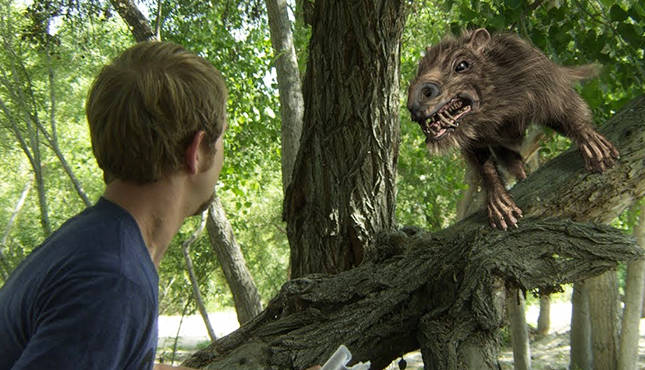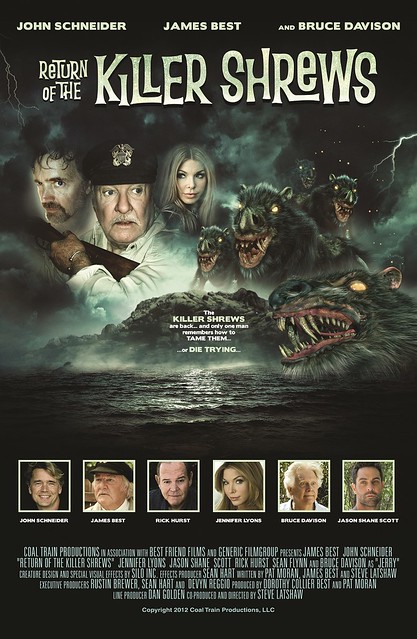Movies & TV / Columns
411 Talks With Makeup Effects Artist Jeff Farley About Return of the Killer Shrews

The 411 Interview: Jeff Farley
Jeff Farley is a movie and TV special makeup effects artist who has been in the business, according to imdb, since at least the mid-1980’s. Farley has worked on both major studio productions like Demolition Man and tons of smaller independent productions like Peacemaker (1990), Robot Jox, and Scanner Cop II, among others (he’s worked with Charles Band’s Full Moon multiple times). Farley has also worked in television, doing work for shows like FreakyLinks, BlackBoxTV, and Quarry. In this interview, Farley talks with this writer about his work on Steve Latshaw’s Return of the Killer Shrews (now available on Video On Demand via iTunes, Amazon, and Google), his career, and more.
**
Bryan Kristopowitz: How did you get involved with Return of the Killer Shrews?
Jeff Farley: I had known Steve Latshaw for quite a while since Dark Universe, Jack-O, and Stan Lee’s Lightspeed. I was contacted while I was in pre-production on Universal Soldier 4. Return of the Killer Shrews was a once-in-a-lifetime opportunity and I was happy to get involved.
BK: What was it like working with Return of the Killer Shrews director Steve Latshaw?
JF: Steve knows what he wants and along with his extensive experience, makes him a very easy director to work with.
BK: What sort of effects were you directly responsible for on Return of the Killer Shrews?
JF: I was brought on to not only handle the limited amount of makeup effects, I also designed the Shrew and fabricated a cable-controlled full-scale puppet of the creature.
BK: What was the hardest effect you had to produce for Return of the Killer Shrews? What was the easiest?
JF: The most difficult effect by far was the puppet which took a few weeks to build. The easiest was the p.a. whose arm was ripped out of the socket.
BK: How has the special effects business changed since you started in the mid-1980’s?
JF: Mostly the budget levels on low to mid-level films have bottomed-out and schedules are shortened.
BK: You’ve worked on big Hollywood movies like Demolition Man and Licence to Kill, and you’ve worked on smaller, independent movies like 976-Evil II and Scanner Cop II, among others. How is working on a big Hollywood movie different than working on a smaller independent movie? How is it the same?
JF: When I do go to set, generally, the difference is in production value. More money equals more amenities such as trailers, while a lower-budgeted film has less to spend on the frills. The similarities mainly are due to the fact that you have schedules every day to meet.
BK: What was it like working on the early 2000’s TV show Freaky Links?
JF: That was a tough show to run, but (the late) John Vulich was completely supportive. One highlight was working with Dan Roebuck and Angus Scrimm for an episode.
BK: Is producing special effects for television similar to producing special effects for a small, independent movie in terms of time and money?
JF: Television usually has better money to spend per episode of a show than an independent feature. Schedules can be very similar, though.
BK: You’ve worked with Charles Band and Full Moon Entertainment multiple times. How did that relationship develop?
JF: I recall seeing films like The End of the World and Laserblast in the theater and thought I’d like to work for Charlie one day. I was eventually hired at John Buechler’s company during the final year of Empire Pictures and ended up in Italy for the production of Arena. Later, I was brought onto the production of The Killer Eye and ended up staying with Full Moon on-and-off for nearly 20 years. Charlie is a wonderful guy and I am proud to have been able to be involved.
BK: What was it like working on the 1990 sci-fi action movie Peacemaker with Robert Forster and Robert Davi?
JF: John Blake was the department head and brought me on for a couple of days during the shoot to do some makeup and a gag in which we added melted gelatin to a cast of Robert Forster’s head utilizing stop-motion animation techniques. I do recall doing a burn makeup on Robert’s hand and him being very nice.
BK: In general, how is working on a science fiction movie different than working on a horror movie in terms of special effects?
JF: Much less blood. LOL!
BK: What is it people don’t understand about special effects on a movie or TV show?
JF: I’m not sure there’s much secret anymore such as when I was a kid and finding information was next to impossible. I guess if a person wasn’t involved in any way, they may not understand that it is a job like any other. It’s less than glamorous.
BK: What’s the hardest special effect you’ve had to pull off in your career so far?
JF: That’s a tough question to answer as there’s always a level of difficulty to each gag or effect. I could say that creating the prosthetics and suits for Python in Stan Lee’s Lightspeed in 18 days with a third of the budget I asked for. With an amazing group of talented people, we got it done.
BK: Who are your moviemaking heroes?
JF: The film makers I admire are The Three Sergio’s… Leone, Corbucci and Solima, along with Gianfranco Parolini, Enzo G. Castellari, Lucio Fulci, Giuliano Carnimeo. Of course I also admire a great deal of effects artists also.
BK: Any upcoming projects you can tell us about?
JF: I designed prosthetics for a couple of kids films directed by Bill Butler, My Babysitter The Superhero and The Three Bears and the Perfect Gift. Those will be released soon. I also have a puppet effect for a psychological horror film currently shooting titled The Uncanny as well as preparing prosthetic designs for Bill Oberst Jr.’s one man stage show, Ray Bradbury Live (forever).
BK: What is cooler, the Gingerdead Man or the Evil Bong?
JF: That’s a loaded question because I worked with both. Let’s just say that I have a soft-spot for the both of them.
**
A very special thanks to Jeff Farley for agreeing to participate in this interview and to david j. moore for setting it up.
Return of the Killer Shrews is now available on Video on Demand via iTunes, Amazon and Google.
Check out the Return of the Killer Shrews official website here.
Check out the Return of the Killer Shrews Facebook page here.
Check out my review of Return of the Killer Shrews here.
Return of the Killer Shrews poster image courtesy of Steve Latshaw. All other images courtesy of Jeff Farley.












